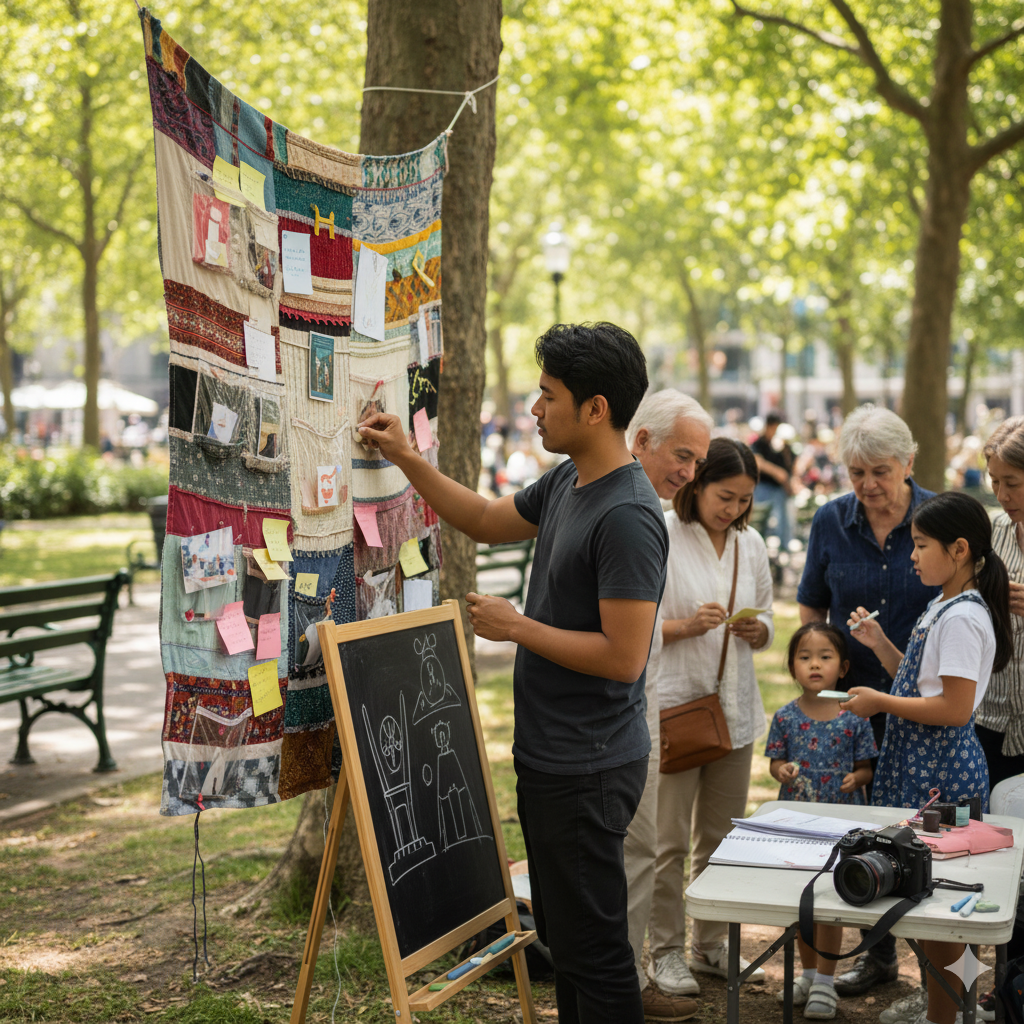🔎 What it is
Arts-Based Research is a type of qualitative research that uses art forms — photos, drawings, music, poetry, performance, film, storytelling — to collect, analyze, and/or share knowledge.
👉 The key idea: some human experiences are hard to capture with just numbers or even words.
Art can reveal feelings, stories, and insights that ordinary surveys or interviews might miss.

🛠️ Methods of Arts-Based Research (with Examples)
1) Photovoice
- Participants take photos to represent their daily experiences.
- Then they discuss the meaning behind those photos.
💡 Example: Homeless youth take pictures of “barriers to safety” in their city (locked bathrooms, crowded shelters). These photos are shared with policymakers to push for change.
2) Poetry / Narrative Writing
- Research data (like interview transcripts) is reshaped into poetry or short stories.
- This form highlights emotions and hidden meanings in people’s words.
💡 Example: Survivors of a natural disaster are interviewed. A researcher turns their words into poems that express grief, resilience, and hope. These poems are later performed at a community memorial.
3) Performance / Theater
- Stories or themes from research are turned into plays, skits, or monologues.
- Performances allow wider audiences to see, feel, and connect with the findings.
💡 Example: Refugees’ experiences are transformed into a stage performance. The play is shown to the public and policy leaders to build empathy and push for more supportive policies.
4) Visual Arts (Painting, Drawing, Collage)
- Participants create artwork (drawings, paintings, collages) that represent their experiences.
- The artwork itself is data, and discussions around it add depth.
💡 Example: Hospital patients draw pictures about how they feel during treatment. Some draw storms, others sunshine — revealing emotional states that surveys might not capture.
5) Music and Dance
- Songs, rhythms, or dances can carry deep cultural meaning.
- Researchers may use them as data, or co-create performances with participants.
💡 Example: Indigenous communities use traditional songs in a research project about cultural resilience. The songs are recorded and analyzed as both cultural heritage and research findings.
📌 Why Use Arts-Based Research?
- Accessibility
- Art speaks to the heart. Findings can reach people who may not read academic reports.
- Policymakers, communities, and the general public can engage emotionally with the work.
- Expression Beyond Words
- Some experiences are too painful, complex, or abstract to describe in plain language.
- Art gives participants another way to express themselves.
- Empowerment
- Participants become creators, not just “subjects.”
- They take ownership of their stories and how they are represented.
- Capturing Complexity
- Art can hold contradictions, emotions, and nuance in ways that charts cannot.
🧾 Example: Arts-Based Research in Action
Topic: Experiences of refugee children in school.
- Data collection:
- Children are invited to draw pictures of “a good school day” and “a hard school day.”
- They also take photos of things in their school that help or hurt learning.
- Analysis:
- Researchers and children sit together to discuss the drawings and photos.
- Themes emerge: kindness from teachers, feeling excluded in language class, safe spaces like the library.
- Presentation:
- The children’s artwork and photos are displayed in a community art gallery.
- Teachers and school officials attend.
- Instead of just reading numbers, they see and feel the children’s experiences.
- Impact:
- The school adds a peer-language support program.
- Teachers receive new training on inclusion.
⚖️ Strengths vs. Challenges
Strengths
✅ Engages people emotionally.
✅ Gives participants control of their own stories.
✅ Produces results that are easy to share with broad audiences.
Challenges
❌ Harder to analyze systematically (a poem doesn’t fit into a spreadsheet).
❌ Some academic audiences may not take it as seriously.
❌ Requires sensitivity to avoid misusing people’s creative expressions.
🗣️ Layperson’s Takeaway
Arts-Based Research = using art to understand people’s lives.
- Photos, poems, plays, paintings, songs — all can be “data.”
- Art helps people express things they can’t always say.
- It makes research more human, creative, and impactful.
👉 Quick way to explain:
“Sometimes numbers and interviews aren’t enough. Arts-Based Research uses photos, drawings, plays, or poems to capture the human side of experience and share it with others









Leave a Reply